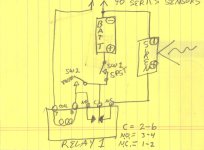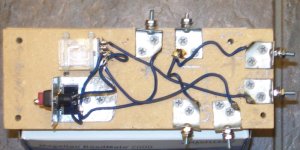patrick_g
Elite Member
A friend of mine is building a house and is concerned with theft of tools. Another friend who recently built a house had the door to his garage kicked in and all his power tools, including table saw etc) and other goods too, taken, never to be seen again.
I told both of them a penny spent on prevention is worth many dollars in tools saved.
One out of two listened and he is interested in an alarm for his shed at the house site.
I built a simple alarm years ago and so I just drew it up from memory and built another one for my friend. It is a pretty basic system, easy for DIY. It is intended for when someone is close enough to hear the siren but could be easily remoted with a radio link. One version I helped a coworker install in his car, paged him if the car's security was compromised. That was sufficient for him because he was within a few hundred feet of his car (but out of sight) when he was concerned with theft.
Anyway I am attaching the schematic for a simple version.
Circuit description:
Batt: I used an old 12 volt car battery but could be a lot smaller, a motorcycle battery or starting battery for a lawn mower or...
Siren: I had an old 12 volt DC motor driven siren but you can buy an electronic siren cheap or use an inexpensive air horn from Harbor Freight or J.C. Whitney. Any 12 volt DC operated noise maker is OK if it doesn't exceed the current rating of the relay contacts.
Relay: The relay I used this time is a DPDT 12 volt relay with 12 amp contacts. A SPDT relay would do fine. I wired the contacts in parallel to get more current handling in case my buddy want a real kick butt noisemaker.
Switch 1: is a simple on/off switch SPST. I used a labeled toggle switch but a $0.69 light switch from Lowe's would be fine.
Switch 2: is a momentary contact SPST switch, essentially a doorbell button.
The other component (not shown) is a battery maintainer which are often on sale for way under $10 at Harbor Freight. By using a battery the alarm system can not be disabled by turning off the AC power
The arrows labeled "to series sensors" in the schematic drawing represent two wires that go to the sensors which are all wired in a "daisy chain" like cheap Christmas tree lights. YOu can put a few nails around a window opening and zig zag some small gauge wire across it. This constitutes an effective window sensor. If the wire is broken the alarm sounds. Restoring the wire does not stop the alarm which runs till the battery goes down (can be several hours) or the alarm is turned off.
You can buy magnetic switches with an accompanying magnet to put on the door and door frame so if the door is opened the alarm goes off. Again, closing the door does not shut the alarm off.
How does it work?
When it is wired up and installed with the series sensors you arm it by pressing and holding down the momentary contact switch (door bell button AKA Sw 2) and turning the Off/On switch (SW 1) to the On position and then release the push button.
The alarm is now armed and the little current draw of the relay coil is flowing in all the series sensors. If a sensor is "violated" this interrupts the current through the relay coil and it de energizes which lets the (C) Common contact of the relay touch the NC Normally Closed contact which puts battery power to the siren until the battery runs down or the Off/On switch is turned off. There is nothing that can be done to the sensors that will shut the alarm off, a desirable trait.
If you buy all the components new (including a battery) and use a new automotive air horn for your noise maker it could cost $50-$100 to make one of these. If you scrounge a bit, get horns from the junk yard, have or can find a used car battery and so forth but buy the relay (less than $10) then you can build one of these easily for $10-$20.
Be creative... the push button can be replaced with a piece of flexible multi strand wire with which you make momentary contact. You may have a battery charger to use on it a few hours a month to keep the battery charged. YOu can scrounge up and substitute for most everything it takes to make the circuit except I don't recommend making your own relay. They can be found under $10 at radio shack or at RadioShack- Audio/Video Electronics, MP3, LCD TVs, GPS, Digital Cameras, DVD Players, Accessories
This same sort of arrangement can be used to alarm a trailer or a tractor or implement or... Wrap a wire around or through the item of interest and include that wire as a series sensor. The wire will be broken if someone takes the item. Sometimes all it takes is a siren going off to chase away a thief, often empty handed.
Of course you could post a sign to the effect that for public safety a warning siren will sound a few seconds before target practice begins. A 12 volt DC light aimed at the protected device and powered by putting it in parallel with the noise maker os a good thing if protecting a tractor or implement. Then in additioin to the loud attention getting noise the would be thief is "in the spot light" so to speak.
Note: the numbering of your relay may be different from the RS unit I bought.
Pat
I told both of them a penny spent on prevention is worth many dollars in tools saved.
One out of two listened and he is interested in an alarm for his shed at the house site.
I built a simple alarm years ago and so I just drew it up from memory and built another one for my friend. It is a pretty basic system, easy for DIY. It is intended for when someone is close enough to hear the siren but could be easily remoted with a radio link. One version I helped a coworker install in his car, paged him if the car's security was compromised. That was sufficient for him because he was within a few hundred feet of his car (but out of sight) when he was concerned with theft.
Anyway I am attaching the schematic for a simple version.
Circuit description:
Batt: I used an old 12 volt car battery but could be a lot smaller, a motorcycle battery or starting battery for a lawn mower or...
Siren: I had an old 12 volt DC motor driven siren but you can buy an electronic siren cheap or use an inexpensive air horn from Harbor Freight or J.C. Whitney. Any 12 volt DC operated noise maker is OK if it doesn't exceed the current rating of the relay contacts.
Relay: The relay I used this time is a DPDT 12 volt relay with 12 amp contacts. A SPDT relay would do fine. I wired the contacts in parallel to get more current handling in case my buddy want a real kick butt noisemaker.
Switch 1: is a simple on/off switch SPST. I used a labeled toggle switch but a $0.69 light switch from Lowe's would be fine.
Switch 2: is a momentary contact SPST switch, essentially a doorbell button.
The other component (not shown) is a battery maintainer which are often on sale for way under $10 at Harbor Freight. By using a battery the alarm system can not be disabled by turning off the AC power
The arrows labeled "to series sensors" in the schematic drawing represent two wires that go to the sensors which are all wired in a "daisy chain" like cheap Christmas tree lights. YOu can put a few nails around a window opening and zig zag some small gauge wire across it. This constitutes an effective window sensor. If the wire is broken the alarm sounds. Restoring the wire does not stop the alarm which runs till the battery goes down (can be several hours) or the alarm is turned off.
You can buy magnetic switches with an accompanying magnet to put on the door and door frame so if the door is opened the alarm goes off. Again, closing the door does not shut the alarm off.
How does it work?
When it is wired up and installed with the series sensors you arm it by pressing and holding down the momentary contact switch (door bell button AKA Sw 2) and turning the Off/On switch (SW 1) to the On position and then release the push button.
The alarm is now armed and the little current draw of the relay coil is flowing in all the series sensors. If a sensor is "violated" this interrupts the current through the relay coil and it de energizes which lets the (C) Common contact of the relay touch the NC Normally Closed contact which puts battery power to the siren until the battery runs down or the Off/On switch is turned off. There is nothing that can be done to the sensors that will shut the alarm off, a desirable trait.
If you buy all the components new (including a battery) and use a new automotive air horn for your noise maker it could cost $50-$100 to make one of these. If you scrounge a bit, get horns from the junk yard, have or can find a used car battery and so forth but buy the relay (less than $10) then you can build one of these easily for $10-$20.
Be creative... the push button can be replaced with a piece of flexible multi strand wire with which you make momentary contact. You may have a battery charger to use on it a few hours a month to keep the battery charged. YOu can scrounge up and substitute for most everything it takes to make the circuit except I don't recommend making your own relay. They can be found under $10 at radio shack or at RadioShack- Audio/Video Electronics, MP3, LCD TVs, GPS, Digital Cameras, DVD Players, Accessories
This same sort of arrangement can be used to alarm a trailer or a tractor or implement or... Wrap a wire around or through the item of interest and include that wire as a series sensor. The wire will be broken if someone takes the item. Sometimes all it takes is a siren going off to chase away a thief, often empty handed.
Of course you could post a sign to the effect that for public safety a warning siren will sound a few seconds before target practice begins. A 12 volt DC light aimed at the protected device and powered by putting it in parallel with the noise maker os a good thing if protecting a tractor or implement. Then in additioin to the loud attention getting noise the would be thief is "in the spot light" so to speak.
Note: the numbering of your relay may be different from the RS unit I bought.
Pat
Attachments
Last edited:


